Christine Janumala
Durbar Mahila Samanwaya Committee
Kolkata, West Bengal, India
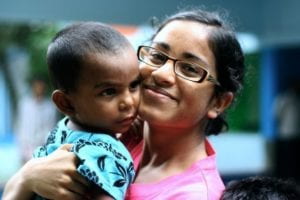
As I sit in Kolkata’s Au Bon Pain writing to a soundtrack of airy café music, a man walks by the window led by his capuchin monkey. At first I mistook her for a tawny street cat, but the monkey’s face is startlingly animate, tender, motherly, and her baby clings to her underbelly with the same soft stare of a street child.
The first time I saw the traveling troupe, it was through a window in a Vodaphone store after nearly three hours of standing in line trying to get an international SIM card. (The wait would extend another three hours the next day.) Seeing a man walk a monkey while I was sitting surrounded by the latest touchscreens has become the visual mascot for what I love about the city. It’s not just the City of Joy; it’s a city of joyful, in-your-face, laugh-out-loud paradoxes. It’s an ashram of absurdity and a meditation on flexibility. It may be a tough pill at times, but with the density of sweet shops in West Bengal, there’s always a spoonful of sugar nearby.
The man and his monkeys usually perform their little drum skit outside of one of the area’s most expensive hotels here on Park Street. Businessmen crowd around, smoking sleek cigarettes and dropping coins into the monkey’s palm. Drive west to the river and the city’s slums rise like funeral ash from the swollen banks of the Hooghly. Drive east to Kolkata’s luxury Quest Mall and find 6 floors of brands from Gucci, Armani, Prada, Michael Kors, Swarovski. India has always held a place of surreality in my heart, as both my homeland and a land of strangers, but rarely does a city thrust this surreality as sharply into focus as Kolkata can.
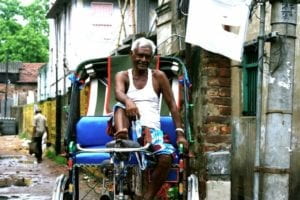
My journey here thus far has taken a road as long and winding as any of these curving city streets. My first lesson in flexibility came after I had already been named a Gallatin Global Fellow. My original placement in Berlin fell through and I found myself in Kolkata instead. I had not expected to come back to India. I was born in South India, in a city called Chennai, but had been raised in California since I was 3. I had returned twice, once when I was 9 and again when I was 12, to visit my family in the south.
Kolkata, on the other hand, is a city so culturally, linguistically, and geographically distant from my family’s region that it is just as foreign to them as it is to me. Yet after nearly a month here, I can’t imagine a place that could have taught me more about trafficking (my area of interest here) as well as progressivism, paradoxes, and myself.
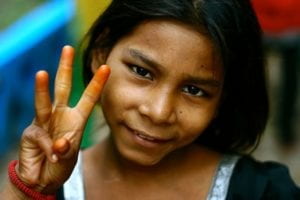
My first days in India, before I began my 9-week internship placement, I volunteered with Mother Teresa’s Missionaries of Charity. I washed street children and was attacked with baby powder in return. I spoon fed a girl as old as me who had cerebral palsy. The community of international volunteers, many of whom also stay at the Baptist Missionary Society Guesthouse with me, is a rotational family of Mexicans, Americans, Canadians, Spaniards, Russians, Italians, Koreans, Finns—all of whom have been great viewing partners for the World Cup.
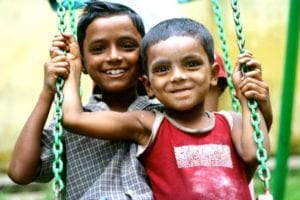
My internship itself began three days after I arrived. Durbar Mahila Samanwaya Committee is a collective of 65,000 sex-workers across West Bengal advocating for the decriminalization of prostitution. Explaining this project to locals and other international volunteers has been a demanding verbal dance.
“Are you trying to get them out of the brothels?” — No, they consider them their homes.
“Do you try to get them to do other work?” — No, they consider this their work.
“So, what does Durbar actually do?”
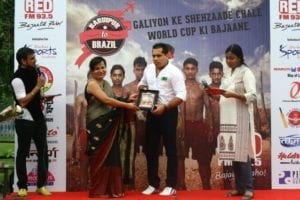
Durbar, as I’ve learned firsthand, does quite a lot. They offer vocational programs for women leaving sex work, educational services for children of sex-workers, a self-sustained lending cooperative, two boarding homes, a cultural activity troupe, HIV/AIDS testing and prevention services, an LGBTQ community, and my arena of focus: self-regulating boards to combat trafficking.
The organization is located in Kolkata’s red-light area, known as Sonagachi, home to 11,000 of India’s 3 million or so sex-workers. The 2005 Oscar-winning documentary, Born into Brothels: Calcutta’s Red Light Kids , propelled Sonagachi’s many residents and frequenters into international focus. However, despite the film’s international acclaim, it has faced stark criticism for its unilateral treatment of prostitution as being synonymous with child endangerment and neglect. Sonagachi has a robust history of advocacy and activism through Durbar and other internationally respected community-based organizations in the region, yet such local groups were never mentioned in the film.
The Sonagachi I see is not the Sonagachi of the film. It is just too simple to decry Sonagachi’s poverty and sexual trade without addressing the roots of these conditions—roots which, like the base of a banyan tree, are twisted and deep. These roots reach to bitter wells of misogyny, caste hierarchies, patriarchal fixation, and sexual repression. Yet despite these apparently oppressive beginnings, the people here are strong. Whether transgendered, HIV-positive, sex-workers, or children of sex-workers, none of them offer an apology in their eyes or ask for pity. They stand as proud members of a committee and a community they themselves have built and envisioned.
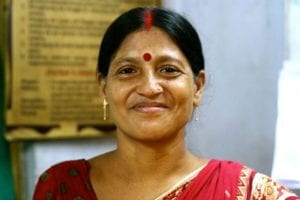
The infrastructure and network that Durbar offers its members—a society of social cast-outs—is more efficient than many of Kolkata’s competing non-profits and underfunded governmental agencies. Durbar’s Self Regulatory Boards (SRBs) illustrate this well. They are unusual in the anti-trafficking community. Much as Born into Brothels depicts the children of Sonagachi as desperately in need of rescue and rehabilitation, most contemporary trafficking perspectives offer the same semi-infantilizing approach.
The DMSC refers to this as “patriarchal legislation,” which attacks trafficking through efforts like tightened border control, tougher anti-prostitution laws, and severe sentencing. However, this often diminishes the capacity for a trafficking victim to become anything other than a victim of trafficking in the government’s eye, and this reduces her ability to seek redress from exploiters and represent herself and her will.
In my conversations with the residents of Sonagachi, many women have described their trafficking experience with a nonchalance that is almost startling. For most, their trafficker was a lover or a close friend. Their experiences are very varied, but their willingness and strength in discussing these experiences is indicative of a solidarity they all share.
Durbar has offered them a voice beyond victimhood, where their retelling is not merely a rekindling of trauma but an opportunity to reflect on what civil and political society needs to know and understand about trafficking from an individual rights perspective. For example, there is the young woman pursuing a vocal music career after intervention through the SRB system. There is also the SRB board member who was both a victim of trafficking and later a willing sex worker. These women’s experiences indicate that trafficking cannot be summarily treated by blanket legislation or tightened migration laws. Rather, as Durbar proudly proclaims, “only rights can right the wrong.”

Before I left, one of my biggest questions was how to prepare for the sadness here, but so far I’ve found little. The women laugh easily; it is as common a sound here as that of bangles clinking on their arms. They joke and tease the men—doctors and client alike—in stark contrast to the down-turned glances often sported by most women outside the community. My research has put me in conversation with many survivors, some of whom have continued sex-work and some of whom chose not to. I deeply believe that Kolkata’s singular message to me has been of empowerment despite (or perhaps through) patience and paradox. The women here are unafraid to question the mental shackles of many of those trying to “rescue” them.
When I am asked what I am learning here, I struggle to put it into words. How can I begin to explain I am learning cheerfulness from trafficking survivors? Political progressivism from retired prostitutes? That the words of those targeted for rescue, for rehabilitation, have been pivotal in rescuing me from my own narrow expectations? Often all I can say is that I am learning why this is called the City of Joy.